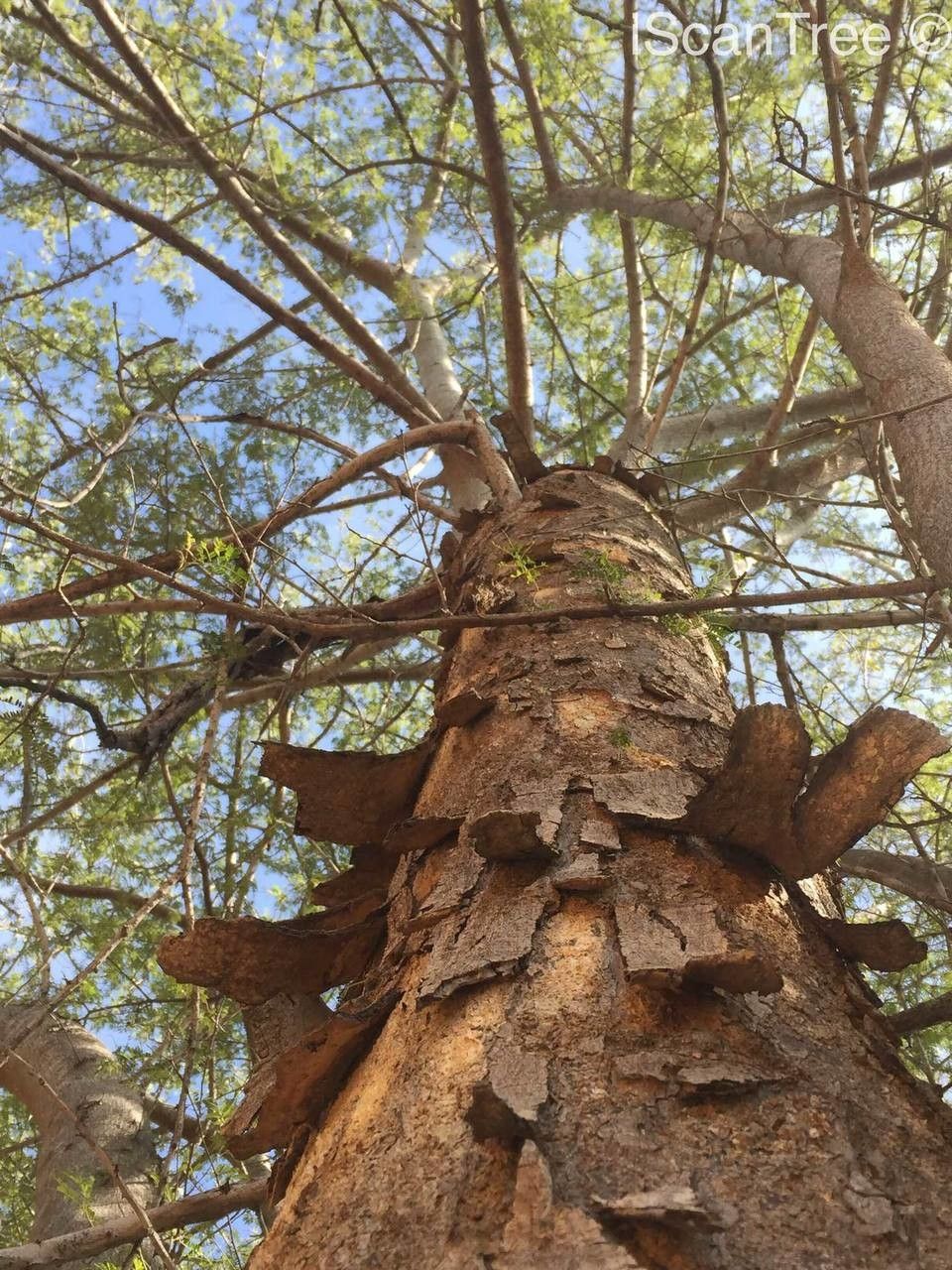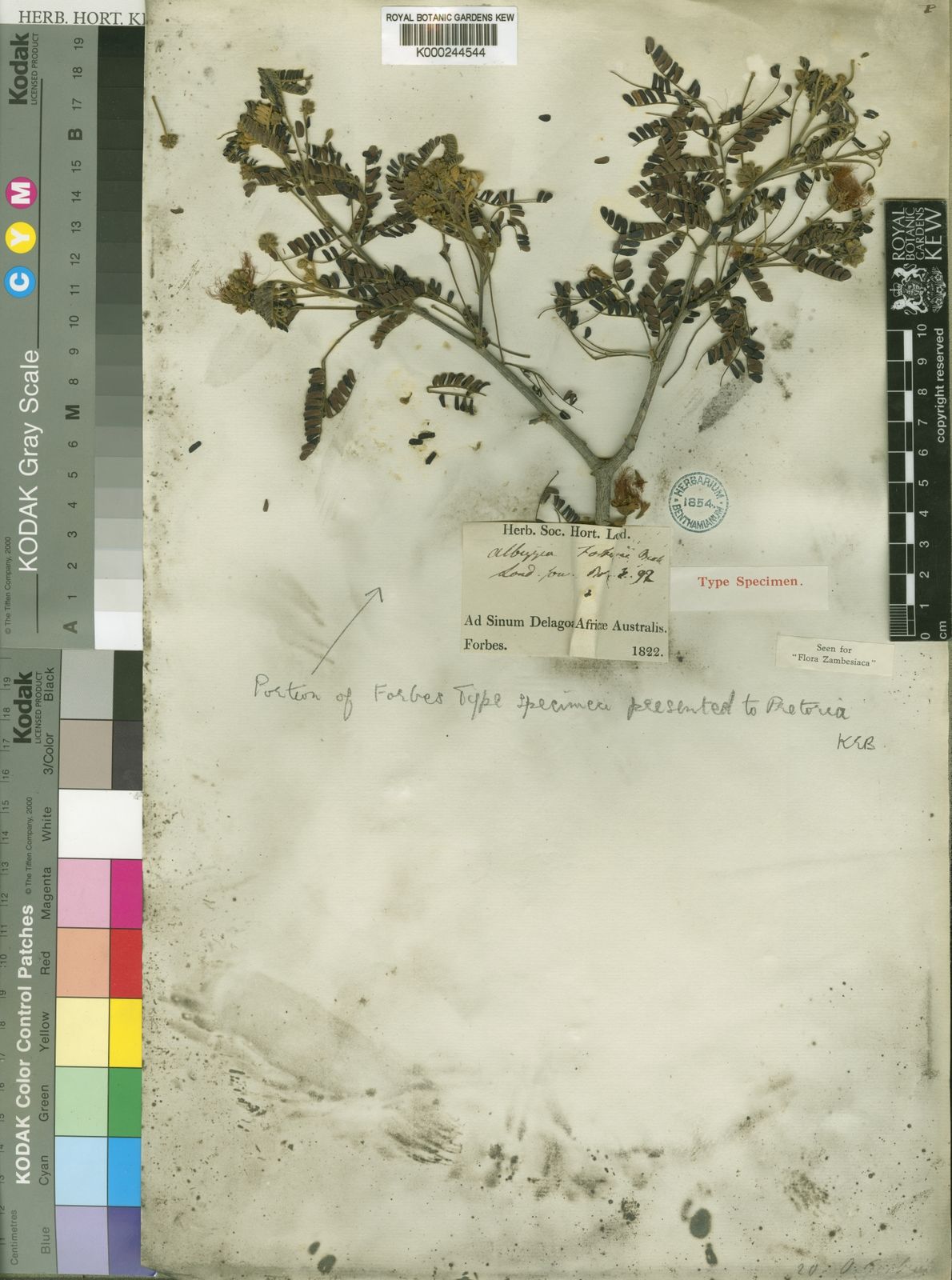Forbes' Silk Tree
albizia forbesii
Also known as: ["Forbes' Albizia"]
Overview
A deciduous tree native to tropical regions, characterized by bipinnate leaves and fragrant flowers.
Benefits & Perks
["fragrant flowers","wildlife attractant (bees, butterflies, birds)"]
Botanical Classification
| Phylum: | Magnoliophyta |
| Class: | Magnoliopsida |
| Order: | Fabales |
| Family: | Fabaceae |
| Genus: | Albizia |
| Botanical Name: | Albizia forbesii |
Plant Characteristics
Basic Information
- Category: Trees
- Suitable Location: outdoor garden in tropical or subtropical regions
- Suitable For:
- Is Weed: No
- Allergenicity: low
Environmental Needs
- Climate: {"temperatureRange":"15–35°C"}
- Hardiness: {"zones":"9–11"}
- Misting: rarely required, only if ambient humidity is very low
- Drainage: Fast-draining to prevent waterlogging.
- Soil Type: Well-draining, loamy soil with added organic matter.
Maintenance Level
- Maintenance Level: moderate
- Toughness Level: moderate
- Pruning Frequency: Annually in late winter or early spring before new growth begins.
- Pruning Intensity: Moderate; remove up to one-third of old growth if needed.
Care Details
Ideal Sunlight Coverage:
Full sun to partial shade; 6–8 hours of direct sunlight daily, with some afternoon shade in hot climates.
Sunlight Tolerance Tips:
Acclimate gradually to intense sunlight; protect from harsh midday sun; adjust placement based on outdoor vs. indoor conditions.
Care Requirements
Care Difficulty
moderatemoderate
Sunlight
full sun to partial shade
Rotate plant for even light exposure; use sheer curtains to filter intense sun; monitor for sunburn.
Watering
every 7–10 days during active growth, reduce in winter
Water thoroughly but infrequently; ensure proper drainage; adjust based on season and growth stage.
Soil
well-draining, loamy soil with moderate organic content
pH: Slightly acidic to neutral, pH 6.0–7.0.
Use a mix of potting soil and perlite; avoid heavy clay soils; ensure pots have drainage holes.
Temperature
Prefers warm temperatures, 65–85°F (18–29°C); tolerates mild frosts but thrives in tropical to subtropical climates.
Protect from frost; ensure good air circulation; adjust watering in extreme heat.
Fertilizing
every 4–6 weeks during growing season with balanced fertilizer
Fertilize only when actively growing; flush soil occasionally to prevent salt buildup; use organic options for slow release.
Propagation
Methods
Stem cuttings or seeds; stem cuttings are more reliable for home growers.
Step-by-Step Propagation Guide
- Take a 4–6 inch cutting.
- Remove lower leaves.
- Apply rooting hormone.
- Plant in medium.
- Keep moist and warm.
Best Time: Spring or early summer when the plant is actively growing.
Environment
Warm, humid environment with indirect light; maintain temperatures around 70–75°F (21–24°C).
Medium
Well-draining mix of perlite and peat moss or cactus mix.
Hormone
Rooting hormone is recommended to improve success rates.
Timeline
Roots may develop in 4–8 weeks; establishment may take several months.
Tools Needed
Pruning shears, rooting hormone, small pots, misting spray bottle.
Quick Tips
Use healthy, non-flowering stems; maintain high humidity; avoid direct sunlight during rooting.
Pruning & Repotting
Pruning Guide
Method
Selective thinning and heading back to promote airflow and shape.
Pruning Plan
Prune to maintain shape, encourage bushier growth, and remove dead or diseased wood.
Tools
Pruning shears, loppers, gloves, disinfectant.
Checklist
Disinfect tools; prune dead/diseased wood first; make clean cuts; avoid over-pruning.
Repotting Guide
Best Season
Early spring before active growth starts.
Pot Size
Increase pot size by 2–3 inches in diameter.
Method
Remove plant gently; trim roots if necessary; repot in fresh, well-draining soil with a slightly larger pot.
Suggestions
Repot every 2–3 years or when roots fill the pot; beneficial for growth and health.
Checklist
Check root bound status; prepare new pot with drainage; use fresh soil mix; water after repotting.
Advanced Care Tips
Watering Mastery
Watering Checklist
Check soil moisture; water deeply; ensure drainage; adjust for season.
How to Apply Water Properly
Water at the base of the plant, ensuring moisture reaches the root zone; allow excess water to drain away; water early in the morning to minimize evaporation.
Watering Schedule Tips
Water deeply once the top inch of soil is dry; reduce frequency in winter to prevent root rot.
Soil Improvement
Add perlite or sand for drainage; incorporate compost for fertility; ensure good aeration.
Temperature Stress Management
Signs of Temperature Issues
Leaf drop, wilting, or chlorosis in cold; scorching or stunted growth in excessive heat.
Cold Stress
Slows growth, may cause leaf drop; prolonged cold can damage or kill the plant.
Solution: Move to a warmer location; provide frost protection; avoid overwatering in cold conditions.
Hot Stress
Leaves may scorch, growth may slow, or the plant may wilt despite adequate water.
Solution: Provide shade during peak heat; increase humidity; water more frequently but avoid waterlogging.
Fertilizing Guide
Fertilizing Checklist
Check growth stage; use diluted fertilizer; avoid winter feeding; monitor for nutrient burn.
Fertilizing Method
Use balanced liquid fertilizer diluted to half strength every 4–6 weeks during growing season (spring to early fall); avoid fertilizing in winter.
Common Problems & Solutions
Toxicity Warning
Cats
Non-toxicAlbizia forbesii is not known to be toxic to cats. There are no documented cases of toxicity in felines from exposure to this plant.
⚡ Toxic If:
None
Dogs
Non-toxicAlbizia forbesii is not known to be toxic to dogs. There are no reported cases of adverse effects in canines from exposure to this plant.
⚡ Toxic If:
None
Humans
Non-toxicAlbizia forbesii is not known to exhibit toxic properties to humans under normal circumstances. The plant has not been documented to cause adverse effects through ingestion or contact.
⚡ Toxic If:
None
Frequently Asked Questions
Q: Is Albizia forbesii suitable for small gardens?
A: It can be suitable if pruned regularly, but it may outgrow small spaces over time.
Q: Does Albizia forbesii require full sun?
A: Yes, it thrives in full sun but can tolerate partial shade.
Q: How often should it be watered?
A: Water deeply once a week, adjusting for rainfall and soil conditions.
Quick Reference
| Family: | Fabaceae |
| Care: | moderate |
| Light: | full sun to partial shade |
| Water: | every 7–10 days during activ |
Get Expert Care Tips
Download the Plantious app for personalized care reminders and plant identification!
Google Play App Store






